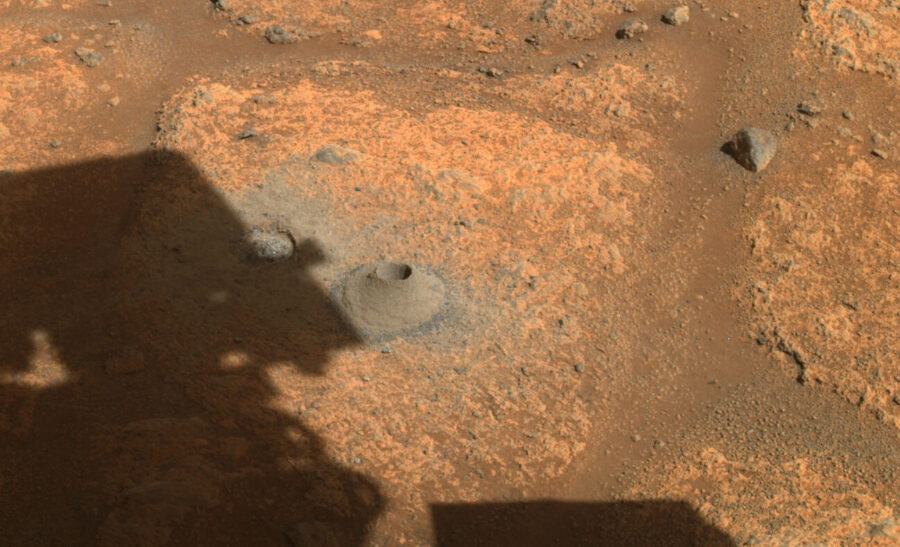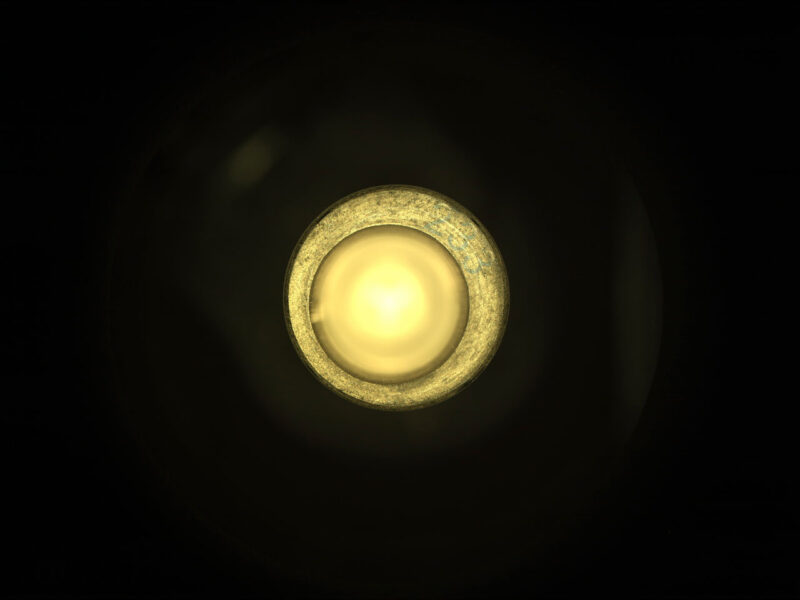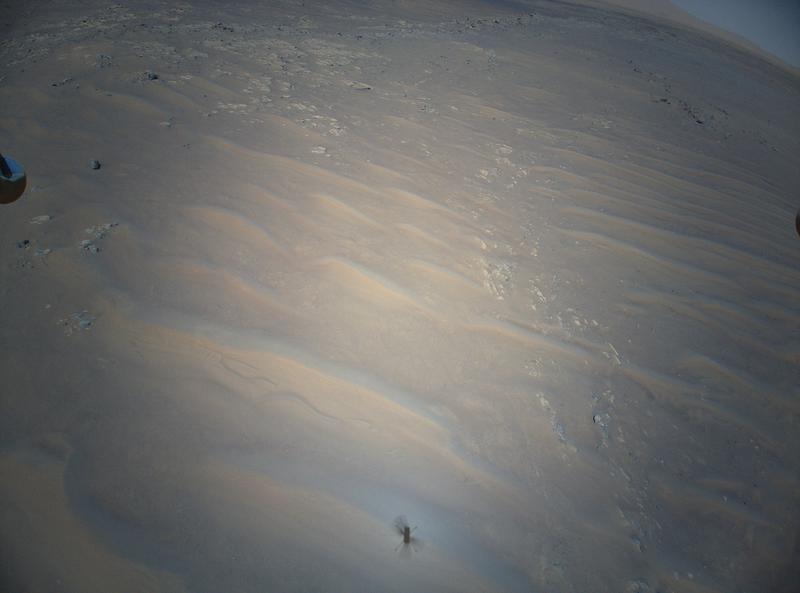Perseverance came up empty on its first attempt to grab and stow a sample of Mars.
Updates:
August 13, 2021: Perseverance is moving on. Engineers have determined that the rock at the bore site was too powdery to produce a core sample. Perseverance will drive to the next sampling site and then try again within the month.

NASA / JPL-Caltech
NASA’s Perseverance rover came up with a curious result on its first sampling attempt last week, when the first tube retrieved by the rover turned up empty. This unexpected outcome is a minor setback — but not something scientists foresaw while working through the sampling process here on Earth. Otherwise, though, the procedure went as planned. Wide-field views show a resulting borehole in one of the flat paver stone rocks on the Crater Floor Fractured Rough site in Jezero Crater.
The First Collection
The sampling process is autonomous, meaning that once a sample site is selected the rover carries out the operation on its own. The Sampling and Caching System worked as expected last week: The system uses a percussive drill along with a hollow coring bit at the end of its 2-meter-long (7 feet) robotic arm to collect chalk-sized sample cores.
However, after the core is placed in the tube, the probe measures the volume of the sample collected. And on this first attempt, the probe did not encounter the resistance engineers expected to see from a filled tube, suggesting that it was in fact, empty. The view from the Sampling and Caching System camera backs up this assertion:

NASA / JPL-Caltech
“While this is not the ‘hole-in-one’ we hoped for, there is always risk with breaking new ground,” says Thomas Zurbuchen (NASA-Science Mission Directorate) in a recent press release. “I’m confident we have the right team working this, and we will persevere toward a solution to ensure future success.”
The rover carries 43 titanium sample tubes, along with five empty ‘witness tubes,’ used to characterize the baseline environment at each collection site. To be successful, the team wants to collect a minimum of 20 filled sample tubes from four separate sites for return to Earth.
#SamplingMars is one of my most complicated tasks. Early pics and data show a successful drill hole, but no sample in the tube–something we’ve never seen in testing on Earth. Mars keeps surprising us. We’re working through this new challenge. More to come. https://t.co/XyXBssvKe6 pic.twitter.com/VTNvMA2jqN
— NASA's Perseverance Mars Rover (@NASAPersevere) August 6, 2021
The complex caching system includes a secondary sample-handling arm that moves the collected cores to the Adaptive Caching Assembly (ACA) on the underside of the rover. In the ACA, the samples are imaged, measured for volume, and sealed. The ACA is one of the most sophisticated and complex mechanisms ever fielded in spaceflight.
Collecting a rock sample from the current site is crucial and would go a long way towards dating the site to a high degree of accuracy. Eventually, the ACA will deposit its samples on the Martian surface for later collection. A future mission will return the samples to Earth sometime in the coming decade.
Drilling on Mars
The surface of Mars has thwarted attempts to dig into it before. Back in 2008, NASA’s Phoenix lander encountered “sticky” soil during attempts to move a clump to the lander for testing. More recently, Mars InSight encountered drilling problems, forcing the team to halt plans to place the heat probe (aka, the “mole”) at its required depth for science operations.
The team is now looking at the data and will use the WATSON instrument on the end of the sampling arm to look at the borehole to see what might have happened.
“The initial thinking is that the empty tube is more likely a result of the rock target not reacting the way we expected during coring, and less likely a hardware issue with the Sampling and Caching System,” says Jennifer Trosper (NASA/JPL). “Over the next few days, the team will be spending more time analyzing the data we have, and also acquiring some additional diagnostic data to support understanding the root cause for the empty tube.”
Meanwhile, the Ingenuity helicopter completed its 11th successful flight, 380 meters downrange. Ingenuity is proving to be a valuable asset in its new operational phase, scouting the treacherous terrain ahead of the Perseverance rover.

NASA / JPL-Caltech
The next site that the Perseverance rover could sample is the nearby Séítah (Navajo for “among the sand”) region, which features a combination of bedrock, layered sediment, and sand dunes. From there, mission planners will head past the original Octavia E. Butler landing site to the intriguing Neretva Vallis flow channel.
Maybe Bruce Willis isn’t needed just yet. For now, we’ll see what the Mars Perseverance team comes up with. There are lots of sample tubes left.
 4
4









Comments
Dan Tilque
August 12, 2021 at 7:09 pm
In this situation, Mark Watney (Matt Damon) would be more useful than Bruce Willis.
You must be logged in to post a comment.
AB
August 15, 2021 at 10:11 pm
Ha ha! that was my first thought too. Bruce who?
I'm sure Mark Watney would've loved to have had Ingenuity to scout the terrain too 😉
You must be logged in to post a comment.
Monica Young
August 30, 2021 at 2:47 pm
Fair enough, but Mark Watney did more growing of potatoes than drilling, if I recall correctly. The Bruce Willis reference seems more apt 😉
You must be logged in to post a comment.
Andrew James
August 15, 2021 at 6:45 pm
"Perseverance is moving on. Engineers have determined that the rock at the bore site was too powdery to produce a core sample. Perseverance will drive to the next sampling site and then try again within the month."
What ever happened to "never give up, never surrender"? The lack of perseverance here is worrisome! 😉
You must be logged in to post a comment.
You must be logged in to post a comment.